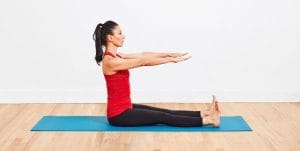Pilates Exercises Beneficial for Osteoporosis
Pilates exercises, when executed correctly, can be particularly beneficial for strengthening the muscles and stabilising the joints, thereby improving bone health for individuals with osteoporosis. Below are detailed descriptions of how to perform each recommended exercise safely. Please make sure to read about the contra-indications at the end!
1. Footwork on the Reformer
Objective
-
- Strengthens the legs and hips, crucial for supporting the spine.
How to Perform
-
- Start by lying down on the reformer with your back flat against the carriage.
- Place your feet on the footbar. Depending on the exercise variant, your feet can be parallel, in a small “V” shape, or wider apart.
- Extend your legs by pressing against the footbar, ensuring that your movements are controlled and the carriage is moved smoothly.
- Keep your pelvis stable and your core engaged throughout the exercise to maintain spinal alignment.
- Slowly return to the starting position by bending your knees, controlling the movement and resistance of the springs.
- Perform 8-12 repetitions, focusing on smooth, controlled movements.
2. Pelvic Curl (Bridge)
Objective
-
- Strengthens the buttocks and lower back, improving pelvic stability.
How to Perform
-
- Lie on your back on a mat with your knees bent and feet flat on the floor, hip-width apart.
- Slowly lift your pelvis towards the ceiling, peeling your spine off the mat vertebra by vertebra, starting from the tailbone and moving upwards.
- At the top of the bridge, ensure your body forms a straight line from shoulders to knees.
- Hold the position for a few seconds, then slowly lower your spine back to the mat, one vertebra at a time.
- Keep the movement controlled to avoid any jerking or sudden motions. Engage your core throughout to support your lower back.
- Repeat 8-10 times.
3. Spine Stretch Forward
Objective
-
- Offers a gentle stretch for the spine in a controlled manner.
How to Perform
-
- Sit up tall on a mat with your legs extended straight in front of you, slightly wider than hip-width apart.
- Extend your arms straight out in front of you, parallel to the floor.
- Inhale deeply, then exhale as you slowly stretch your spine forward, reaching your hands towards your feet.
- Focus on moving from your hips and keeping your back as straight as possible, rather than curling the spine.
- Reach as far forward as comfortable without rounding your back.
- Hold the stretch for a moment, then slowly stack your spine back to the sitting position.
- Repeat 3-5 times, ensuring smooth, controlled movements.
4. Leg Circles on the Reformer
Objective
-
- Enhances hip mobility and strength without stressing the spine.
How to Perform
-
- Lie on your back on the reformer with one leg extended upwards towards the ceiling and the other flat or slightly bent for stability.
- Circle the raised leg clockwise for a specified number of repetitions, then switch to counterclockwise.
- Keep the movements controlled and the pelvis stable to prevent rocking.
- Ensure the rest of the body remains still and engaged to support the spine.
- Perform 5-10 circles in each direction per leg.
5. Side Kicks
Objective
-
- Improves hip and gluteal strength, balance, and functional movements.
How to Perform
-
- Lie on one side on a mat, aligning your body in a straight line from head to feet, and resting your head on your hand or arm.
- Lift your top leg to hip height, keeping it straight.
- Kick the leg forward with control, keeping the torso stable and then swing it back slightly past your initial position.
- Focus on smooth, controlled movements rather than speed.
- Perform 8-12 kicks, then switch to the other side.
Contra-indications
While Pilates offers many benefits, there are certain exercises and movements that should be avoided or modified for those with osteoporosis:
Rolled or Rounded Spine Movements
Exercises that involve rolling the spine, such as the Roll-Up or Rolling Like a Ball, can place too much pressure on the vertebrae and are contraindicated.
Deep Twists
Movements that involve twisting the spine can increase the risk of spinal fractures. Exercises like the Saw or Spine Twist should either be avoided or performed with minimal rotation.
Loaded Flexion
Any exercises that load the spine in flexion, such as certain mat work exercises where the head and shoulders lift off the ground, can be harmful. These include traditional crunches or double leg stretch in a curled position.
Implementing Pilates Safely
Before incorporating Pilates into an exercise regimen for osteoporosis, it is essential to consult with a healthcare provider or a certified Polestar Pilates instructor with experience in managing osteoporosis. They can tailor exercises to individual needs and ensure that movements are performed correctly to avoid injury. Modifications and supports, such as using a Pilates pole for alignment or adjusting the spring tension on equipment, can help make exercises safer and more effective.
Pilates, when practised mindfully and with proper guidance, can significantly enhance bone health and overall physical function in individuals with osteoporosis, improving their quality of life and reducing the risk of fractures.











